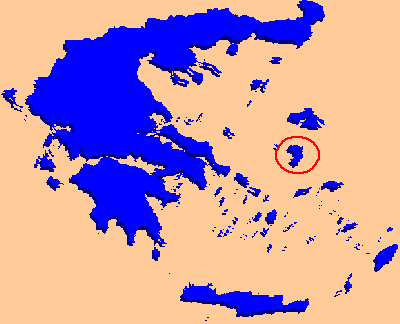 |
Greece Property for Sale - Real Estate In Greece Buy & Sell |
| Chios Property & Houses For Sale - Real Estate In Greece 0 Property(s) Found - Page 1 of 0 - Updated: 4/25/2024 |
|
FEATURED PROPERTIES: Ikaria - Armenistis New Maisonettes Price: €209,000 - 125 m2 Bedrooms: 3 Baths: 2  |
CHIOS
Chios Characteristics
Chios has a land mass of 842 sq. km and a coast line of 213km. It has the smaller nearby islands of Oinouses, Psara, AntiPsara and Pasas within its civic control. Chios is thought to be the birth place of Homer and Christopher Columbus. It is most densely populated in its SE sections and has an airport immediately south of Chios Town. Island Features
Its capital and main port is Chios Town and its other major villages are Thimania, Nentia, Marmaro, and Pirgi. There are many smaller hamlets including Kardamila and Kambos, to the south, is particularly green and beautiful. The western and northern regions have steep rocky cliffs facing the sea. There is a large Greek Army contingent on Chios. Its architecture is unique and varied, and includes the 11th Century Byzatine Nea Moni with its wonderful mosaics. Chios Island Specialites
Other island specialties are kopanitsi, a wonderful blue cheese, and the brown, wrinkled olive chourmades which means dates, (the eating kind). The island also produces good barrel wine. Chios Town
The Byzantine Fortress contains most of Old Chios and is to the right of the harbor. Built upon the ruins of the Macedonian Castle, it was destroyed by the Persian Mithridates. The southwestern entrance, Porta Maggiora, is the most interesting and best preserved entrance to the kastro. Most of what survives from the Turkish occupation is within the fortress. There's a ruined mosque, a Turkish cemetery, and a very small prison. The Kastro Justinian Museum contains detached frescoes, carvings and early Christian mosaics.
A Mosque is within the square and marked with the Turga of the Sutlan (swirling thumbprint) and is a mark of the islands' one-time special status. The Mosque houses the Byzantine Museum (hours: 10-1, Sun 10-3, closed Mon) with a collection of Art and religious icons. The Homerium, on the square's south, serves as the Art Exhibition Hall and community center.
Chios Town has an Archeological Museum at 5 Michalon St. which contains finds from all over the island, some bearing the sphinx, the ancient Chios symbol. The Maritime Museum will please anyone interested in shipping. Around the IslandChios Beaches
Karfas beach to the south is the nearest to Chios Town and reachable by blue bus. The soft sand here is being covered up by hotels and other trappings of tourism. See the map in the map section below for many more beaches. South of Chios Town: The Kambos and Karfas
Mastodon bones were found at Thymiana, outside the Campos walls. Thymiana was the source for Campos' golden building stone. There's a woman's cooperative there that produces rugs, towels, and woven goods. Toward the village of Vivili is the octagonal domed church Panagia Krina, which contains fine Cretan frescoes. Southwest of Chios Town: The Mastikochoria (Mastik growing villages)
Thriving Kalamoti is the next village and boasts cobbled streets and tall stone houses. Kalamoti has a pretty Byzantine church, Ag. Parskevi. It isn't far from the 12th Century church Panagia Sikelia. Sandy Komi is the nearest beach. Pirgi (or Pyrgi) is the largest village of the region and well worth visiting as it contains many architectural details of the period particularly the xista sgraffito style of decoration. In Xista, the walls are covered with mortar containing black sand, then coated with white plaster which is scraped off to create geometric, floral or animal designs. Wander through the remaining villages in the Mastikochoria to see the old mastic-exporting port at Emborio, the impressive tower at Olympi and the fortress at well-preserved mastic village Mesta. There are villages, tavernas, and beaches throughout this region of the island. Inland from Chios Town
The blue buses only go as far as Karyes, a 7km walk from Nea Moni, so if walking is a problem take a taxi to see this monastery. Modest dress is required. The church has a sumptuous double narthex with mosaics of 28 saints, including St Anne. There are many pilasters, niches, and richly colored mosaics. Of artistic merit are the Anastasis, Christ Washing the Disciples' Feet, Betrayal in the Garden, the mosaic of the Virgin, the dome and the Byzantine clock. The Nea Moni is listed as a world heritage site. The closest settlement to Nea Moni is Avgonyma. It's a beautiful and well restored village with a medieval tower. North of Chios Town: Langada, Kardamila and Volissos
Volissos was once the primary market town for the 20 smaller villages in northern Chios. It's located on a fortified hill. Langada, Kardamila, and Marmaros are other unspoilt Northern Chios villages worth visiting. The popular beach, Nagos Beach is north of Marmaros. Pitios is the birthplace of Homer, his "house" and olive grove are still there. Even in the burnt, almost lunar, emptiness of the northernmost reaches of the island there are fortresses, towers, beaches, caves and other interesting things to explore. Drinking and Dining
Much the same can be said for the plethora of restaurants limani side. Avoiding the more blatant and garish eateries, by choosing to eat where the Greeks themselves eat, will reward you commensurately in your search for traditional Greek Food.
For sweets and snacks, the ubiquitous No Name reappears towards the south of the breakwater specializing in dairy-products: yogurts with honey, rice puddings, fried battered Loukoumades drenched with syrup, boxed sweets and more.
Just by the Public Gardens on Democracy St. is another good taverna. Past the ugly hotels to the quay's south is the Nox or nautical club with delicious unpretentious Greek Dishes! History
In 1566 the Turks captured the island and granted it special privileges which held until the Revolution in 1822 when the inhabitants were massacred en mass. In two weeks, almost 30,000 people were massacred. Another 45,000 were taken into slavery. Delacroix painted a famous canvas of the event, now in the Louvre. As if that wasn't enough destruction, Chios suffered a major earthquake in 1881 that killed nearly 4,000 people. Chios was liberated in 1911 and joined the Greek State. The art of soldering metal originated here around 490. Chios was a famous source of sculpture. Some of the most famous Chiot sculptures are the four bronze horses that are now on the front of St Mark's in Venice. But not all its accomplisments are good. Chios was the first Greek state to engage in slave trading. HintsBe on the look out for tourist traps on the waterfront. Ask locals for Authentica Estiatoria or authentic restaurants. If you're trying to avoid tourists, then avoid the small coastal stretch south of Chios Town and you'll be all set for a pleasant stay. Maps
The Complete Details
|
©2024 Real Estate in Greece.net | Contact | | Bookmark Sitemap |


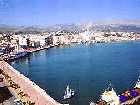
 Chios, population 50,000, lies 27 nautical miles south of Lesvos and 146 nautical
miles from Piraeus. It is less than 5 miles from
Turkey and played an important part in the Greek War For Independence
(1822), when the Turks slaughtered 25,000 rebellious islanders.
Chios, population 50,000, lies 27 nautical miles south of Lesvos and 146 nautical
miles from Piraeus. It is less than 5 miles from
Turkey and played an important part in the Greek War For Independence
(1822), when the Turks slaughtered 25,000 rebellious islanders. 
 Celebrated for its shipowners, gum mastic and friendliness, Chios is a
semi-mountainous island, with its highest peak of Pelinaious, at 1300
meters. It has several verdant valleys and pine forests. It is rocky
and precipitous in the north and flatter in the south and east with
sandy unspoiled beaches. As a larger island, it has many villages mostly concentrated
in the south.
Celebrated for its shipowners, gum mastic and friendliness, Chios is a
semi-mountainous island, with its highest peak of Pelinaious, at 1300
meters. It has several verdant valleys and pine forests. It is rocky
and precipitous in the north and flatter in the south and east with
sandy unspoiled beaches. As a larger island, it has many villages mostly concentrated
in the south. 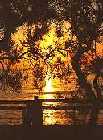 Chios
is famous for its ship owners (think Onassis), beautiful countryside and the
fact that it is the only place in the world where Masticha (gum mastic) is produced. Masticha, is a bitter sweet resin used in
the production of tooth paste, liqueur, chewing gum, varnishes, color
TV sets, cosmetic creams and floor waxes. If you have ever chewed gum,
especially the more natural kind, you've probably tasted a part of Chios
Island. Masticha comes from the Lentisk tree which is bushy and refuses
to yield masticha when it is transplanted anywhere in the world even on
the island! In English the word masticate means to chew... go figure!
Chios
is famous for its ship owners (think Onassis), beautiful countryside and the
fact that it is the only place in the world where Masticha (gum mastic) is produced. Masticha, is a bitter sweet resin used in
the production of tooth paste, liqueur, chewing gum, varnishes, color
TV sets, cosmetic creams and floor waxes. If you have ever chewed gum,
especially the more natural kind, you've probably tasted a part of Chios
Island. Masticha comes from the Lentisk tree which is bushy and refuses
to yield masticha when it is transplanted anywhere in the world even on
the island! In English the word masticate means to chew... go figure!  Chios Town (or Chora), like so
many island towns in Greece was rebuilt after an earthquake. The Nazis,
during their WWII withdrawal, destroyed much of it. When you arrive by ferry, it doesn't
look like a typical Greek Island capital. There are "tall" (5 stories)
ugly concrete buildings with American pool halls, high rise offices, apartment blocks and fast-food joints. There are many sailors and all
that they imply. Move past the waterfront area as quickly as you can!
Chios Town (or Chora), like so
many island towns in Greece was rebuilt after an earthquake. The Nazis,
during their WWII withdrawal, destroyed much of it. When you arrive by ferry, it doesn't
look like a typical Greek Island capital. There are "tall" (5 stories)
ugly concrete buildings with American pool halls, high rise offices, apartment blocks and fast-food joints. There are many sailors and all
that they imply. Move past the waterfront area as quickly as you can!  The streets behind the waterfront are much nicer and more
authentic. Further back
into the town itself, which is sister city to Genoa, Italy, you'll find
more traditional charm.
The streets behind the waterfront are much nicer and more
authentic. Further back
into the town itself, which is sister city to Genoa, Italy, you'll find
more traditional charm.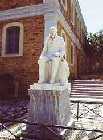 The town
central square Plastira or Platea Vournakiou is
a tree lined expanse with cafes and pastry shops. The Statue of Bishop
Plato Fragiadis stand to one side. Within the city gardens, just
behind, is the statue of Kanaris, Hero of the Revolution.
The town
central square Plastira or Platea Vournakiou is
a tree lined expanse with cafes and pastry shops. The Statue of Bishop
Plato Fragiadis stand to one side. Within the city gardens, just
behind, is the statue of Kanaris, Hero of the Revolution. 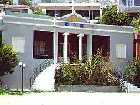 Within the town the early Christian Basilica of St. Isidore and the Cathedral
are open to the public. The Korais Library, one
of the finest in Greece, has a collection of rare manuscripts and books.
On its second floor is the Folklore Museum and collection of Phillpos Argentis.
(hours: 8-2, closed Sun). Among the portraits of the Argentis family are copies of the Massacre at Chios by Delacroix.
Within the town the early Christian Basilica of St. Isidore and the Cathedral
are open to the public. The Korais Library, one
of the finest in Greece, has a collection of rare manuscripts and books.
On its second floor is the Folklore Museum and collection of Phillpos Argentis.
(hours: 8-2, closed Sun). Among the portraits of the Argentis family are copies of the Massacre at Chios by Delacroix. 
 Chios
is fairly non-developed and doesn't receive a lot of tourism. The beaches
in the North are smooth and flat and ideal for invasion according to Greek
Army friends of mine who have had to guard them during their mandatory army
service. One of them told me, "Limia and Agh Markella just opposite
Chios Town are both non-touristic and Nagos and Giossonas in the NE of
the islands have very nice unstructured beaches."
Chios
is fairly non-developed and doesn't receive a lot of tourism. The beaches
in the North are smooth and flat and ideal for invasion according to Greek
Army friends of mine who have had to guard them during their mandatory army
service. One of them told me, "Limia and Agh Markella just opposite
Chios Town are both non-touristic and Nagos and Giossonas in the NE of
the islands have very nice unstructured beaches." 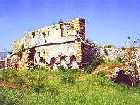 Due
south of town is the fertile plain called the Campos (or Kambos). Many remnants of Chios' Genovese past are still to be seen in the form of
plantations, villas, tall stone wall enclosed gardens, and the tell-tale stripes of Genoese nobility. Well-to-do Genovese overlords lived here
side by side with their Greek serfs from the 14th Century onwards, cultivating
Mastick and Mulberry trees. The latter for the silk producing worms, which
also added to the islands prestige. Nowadays, a few of the mansions have
been preserved and their water wheels (manganos) still turn with the flowing
of the streams. The Argentis Estates and that of the Kazanova Family are
particularly beautiful.
Due
south of town is the fertile plain called the Campos (or Kambos). Many remnants of Chios' Genovese past are still to be seen in the form of
plantations, villas, tall stone wall enclosed gardens, and the tell-tale stripes of Genoese nobility. Well-to-do Genovese overlords lived here
side by side with their Greek serfs from the 14th Century onwards, cultivating
Mastick and Mulberry trees. The latter for the silk producing worms, which
also added to the islands prestige. Nowadays, a few of the mansions have
been preserved and their water wheels (manganos) still turn with the flowing
of the streams. The Argentis Estates and that of the Kazanova Family are
particularly beautiful.  There are
about 20 villages dating from the Middle Ages where Mastick was grown and
these are collectively referred to as the Mastikochoria. The Turks spared
these in 1822 and are of Genovese design purposely planned to confuse would-be invaders. The first village is Armolia, topped
by its Byzantine castle Kastro tis Oreas (1440).
There are
about 20 villages dating from the Middle Ages where Mastick was grown and
these are collectively referred to as the Mastikochoria. The Turks spared
these in 1822 and are of Genovese design purposely planned to confuse would-be invaders. The first village is Armolia, topped
by its Byzantine castle Kastro tis Oreas (1440).  The trip to New Monastery or Nea Moni takes one through some of the
nicest territory on the island. Built
in 1039 AD, partially destroyed in the earthquake
of 1822, it contains some of the nicest examples of Byzantine art in existence.
Also displayed are the bones of some of the 5000 who sought sanctuary
here during the massacre. There's a special chapel for the bones. Axe wounds are visible on many skulls, including those of children.
The trip to New Monastery or Nea Moni takes one through some of the
nicest territory on the island. Built
in 1039 AD, partially destroyed in the earthquake
of 1822, it contains some of the nicest examples of Byzantine art in existence.
Also displayed are the bones of some of the 5000 who sought sanctuary
here during the massacre. There's a special chapel for the bones. Axe wounds are visible on many skulls, including those of children.  The north
of the island is less developed and many of its villages almost deserted
in winter. Vrontados is one exception. Just 5 km from
Chios Town, it's home to many of the island's wealthiest. Homer and Christopher
Columbus are both said to have sat upon its Teacher's Stone (or Daskalopetra),
a rock throne overlooking the sea. It has a small Folklore Museum, the 19th Century Monastery of Panagia Myrtidiotissa and the
International Society for the Study of Homer.
The north
of the island is less developed and many of its villages almost deserted
in winter. Vrontados is one exception. Just 5 km from
Chios Town, it's home to many of the island's wealthiest. Homer and Christopher
Columbus are both said to have sat upon its Teacher's Stone (or Daskalopetra),
a rock throne overlooking the sea. It has a small Folklore Museum, the 19th Century Monastery of Panagia Myrtidiotissa and the
International Society for the Study of Homer. 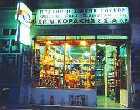 As
mentioned earlier, waterfront Chios suffered from earthquake damage and
was rebuilt without regard for tradition.
As
mentioned earlier, waterfront Chios suffered from earthquake damage and
was rebuilt without regard for tradition.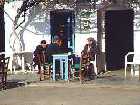
 Quay
side in the north quarter of the port are two good Ouzeries or liqueur - tsipouro bars serving appetizers or mezedes. Chios
is famous for its masticha after dinner liqueur(s), which a make
a surprisingly good gift!! You can see different varieties for
sale above these locally produced barrels of wine in the photo.
Quay
side in the north quarter of the port are two good Ouzeries or liqueur - tsipouro bars serving appetizers or mezedes. Chios
is famous for its masticha after dinner liqueur(s), which a make
a surprisingly good gift!! You can see different varieties for
sale above these locally produced barrels of wine in the photo.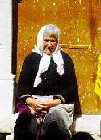 Smack
in the center of the Chios Town is the Taverna Dolphins and spot on while waiting for your boat. To the initiated, the Turkish
influence may be felt easily, as it is fundamental to traditional Greek
cuisine.
Smack
in the center of the Chios Town is the Taverna Dolphins and spot on while waiting for your boat. To the initiated, the Turkish
influence may be felt easily, as it is fundamental to traditional Greek
cuisine. 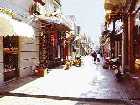 A 10
minute walk from the quay, and Chios' oldest restaurant, is Hotzas
(Stefanou Tsouri 74). It features locally produced barrel wine
and is well worth the walk.
A 10
minute walk from the quay, and Chios' oldest restaurant, is Hotzas
(Stefanou Tsouri 74). It features locally produced barrel wine
and is well worth the walk. 
 Known
as Pityousa and Makre in ancient times, the island has been inhabited since
pre-history. Ionian colonists settled here in the 8th Century BC and 200 years
later its culture had reached a high state. The Persian Wars caused it
to be captured. Later it joined the Athenian League until it passed to
Phillip of Macedon and Alexander the Great. After Alexander, his generals
had control. The Athenians enjoyed a long period of control over the island. Traditon is that Homer was born here in the 9th or 8th Century BC. Eventually the Romans took possession. During the Byzantine
period it was the victim of pirate attacks.
Known
as Pityousa and Makre in ancient times, the island has been inhabited since
pre-history. Ionian colonists settled here in the 8th Century BC and 200 years
later its culture had reached a high state. The Persian Wars caused it
to be captured. Later it joined the Athenian League until it passed to
Phillip of Macedon and Alexander the Great. After Alexander, his generals
had control. The Athenians enjoyed a long period of control over the island. Traditon is that Homer was born here in the 9th or 8th Century BC. Eventually the Romans took possession. During the Byzantine
period it was the victim of pirate attacks.
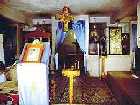 The Latin Emperors and the Venetians fought over Chios. In 1344, it passed
to the Genoese, under whom it flourished due to its monopoly
in the production of Gum Mastic.
The Latin Emperors and the Venetians fought over Chios. In 1344, it passed
to the Genoese, under whom it flourished due to its monopoly
in the production of Gum Mastic. 